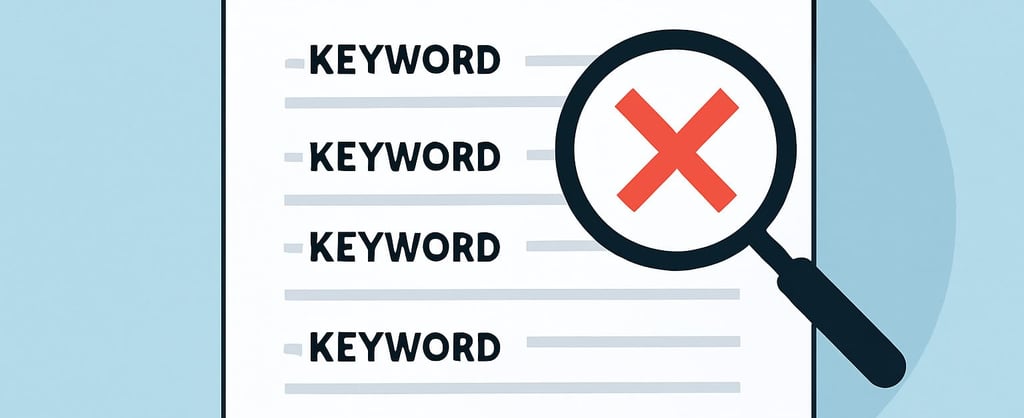Beyond Keyword Stuffing: How to Use AI as Your Ultimate SEO Content Co-Pilot
Let's be honest. SEO content creation can feel like a relentless tug-of-war.
AI BLOGS
editor
8/19/20253 min read


Let's be honest. SEO content creation can feel like a relentless tug-of-war.
On one side, you have Google's sophisticated algorithms, demanding high-quality, user-centric, and semantically rich content. On the other, the pressure to rank, to hit specific keywords, and to churn out volume at a breakneck pace.
For years, we've balanced this with spreadsheets, gut feelings, and endless rounds of edits. But the game has changed. Artificial Intelligence has moved from a futuristic concept to a practical, powerful ally sitting right in your browser tab.
The key isn't to let AI replace you. It's to let it empower you. Used correctly, AI becomes your strategic co-pilot for SEO content optimization, handling the heavy lifting so you can focus on strategy and creativity.
Here’s how to leverage AI to not just create content, but to create content that truly wins.
1. The Foundation: Supercharged Keyword Research & Semantic Mapping
Forget just finding a high-volume keyword. AI tools can analyze the top search results for you and uncover the exact questions, subtopics, and related terms (LSI keywords) that Google associates with a topic.
How to do it:
Prompt for Topic Cluster Ideation: Instead of "keywords for running shoes," ask your AI tool: "Generate a list of semantic keywords, user questions, and subtopics for a comprehensive pillar page on 'how to choose running shoes.' Include terms related to pronation, foot shape, terrain, and shoe anatomy."
Identify Question Intent: Use AI to analyze the "People also ask" and "Related searches" boxes at scale. Ask: "What are the top 10 questions people ask about 'keto diet for beginners'?" This directly informs your H2 and H3 headers.
AI Tools for This: SEMrush's AI Writing Assistant, Frase, MarketMuse, ChatGPT, Claude
2. The Blueprint: Structuring a Data-Backed Content Outline
A great article needs a powerful skeleton. AI can instantly analyze the structure of the top 10 ranking pages for your target keyword and suggest an optimal outline that covers everything searchers want to know.
How to do it:
Prompt for Competitive Analysis: "Analyze the common headings and content structure of the top 5 ranking pages for 'best CRM for small business.' Create a recommended outline that includes all crucial sections and adds unique value they might be missing, like a 'implementation difficulty' section."
Define Content Angle: Ask the AI: "What unique angle could I take on an article about 'home workout routines' that the current top results aren't covering?" It might suggest focusing on "equipment-free workouts for apartments" or "10-minute routines for new parents."
AI Tools for This: Clearscope, Frase, Scalenut, ChatGPT
3. The Draft: Writing with SEO and Readability in Mind
This is where most people start, but it should be step 3. Use AI to generate a first draft based on your brilliant, data-backed outline. This draft will already be infused with relevant keywords and structured for logical flow.
How to do it:
Prompt for Section Writing: Don't just ask it to "write an article." Command it section by section for better quality. "Write a comprehensive, beginner-friendly paragraph for the section titled 'What is Neutral Pronation?' for my running shoe article. Use simple analogies and include the keyword 'neutral pronation' naturally."
Maintain Brand Voice: Prime the AI first! "Write the following section in a professional yet conversational tone, as if explaining to a savvy business owner. Avoid overly technical jargon."
AI Tools for This: Jasper, Writer, Copy.ai, Writesonic, ChatGPT
4. The Polish: Optimizing for the "EEAT" Factor
Google prioritizes Experience, Expertise, Authoritativeness, and Trustworthiness (EEAT). This is where the human touch is non-negotiable. Use AI to enhance these elements.
How to do it:
Fact-Check & Cite Sources: AI can hallucinate. Command it: "Based on the following text, find and link to two authoritative scientific studies that support the claim about collagen benefits." Then, you verify those sources.
Inject Personal Experience: AI has none. Use the draft as a base and add your own anecdotes, case studies, and unique insights. This is what makes the content irreplaceable.
Optimize for Readability: Ask your AI tool: "Analyze this paragraph for readability and suggest ways to shorten sentences and simplify language." Tools like Grammarly and Hemingway Editor also use AI for this purpose.
5. The Final Touch: Meta Magic and Beyond
A perfectly optimized article needs the right packaging to win the click in the SERPs.
How to do it:
Craft compelling meta titles and descriptions: "Generate 5 click-worthy meta titles under 60 characters and 3 meta descriptions under 160 characters for an article titled 'The Ultimate Guide to Sustainable Gardening.'"
Create SEO-Friendly Alt-Text: "Generate concise, keyword-rich alt-text descriptions for these images:
The Golden Rule: You are the Pilot, AI is the Co-Pilot
The biggest mistake is to set AI on autopilot. The magic happens in the collaboration.
You Provide Strategy & Insight. AI provides data & scale.
You Provide Expertise & Voice. AI provides structure & drafts.
You Provide Final Judgment. AI provides suggestions.
AI is the most powerful tool ever created for SEO content optimization. But a tool is only as good as the craftsman wielding it. Use it to automate the tedious, inform the creative, and amplify your expertise. Stop writing for algorithms and start using algorithms to write for humans. That’s how you win.


